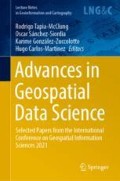Abstract
Clandestine graves are an expression of extreme violence whose findings have increased in Mexico in recent years. In this paper we use two concepts already studied: spatial clustering and clandestine space and integrate them into a spatial model within a web application, with the aim of improving the previous model by reducing the areas with the highest probability of finding more clandestine graves in Baja California (BC), based on information from 52 grave points already located by the local attorney general’s office. The results confirm that, by incorporating the analysis of point patterns, the search area is substantially reduced (\({<}10\%\)). The model ensures that the final search areas will be within practical distances from most urban settlements, 39 min in the case of BC.
Access this chapter
Tax calculation will be finalised at checkout
Purchases are for personal use only
Notes
- 1.
- 2.
Public information access requests are conducted through National Institute for Transparency, Access to Information and Protection of Personal Data (INAI-Plataforma Nacional de Transparencia https://www.plataformadetransparencia.org.mx/web/guest/inicio), which is a website from the Mexican government where citizens can request public information from federal and local authorities, according to the General Law on Transparency and Access to Public Information in Mexico. Authorities are obliged to respond to the information requests within 20 d. Information can be granted or reserved, depending on the sensitivity of the information requested or the authority’s interpretation.
- 3.
ANN was conducted using QGIS and Ripley’s K function was conducted using the R programming language.
- 4.
In the GEE App, the exponent is limited to small integer values of \(\log _2(n)\).
References
Bunch AW, Kim M, Brunelli R (2017) Under our nose: the use of GIS technology and case notes to focus search efforts. J Forensic Sci 62(1):92–98
Cabo LL, Dirkmaat DC, Adovasio JM, Rozas VC (2012) Archaeology, mass graves, and resolving commingling issues through spatial analysis. A companion to forensic anthropology, pp 175–196
Congram DR (2010) Spatial analysis and predictive modelling of clandestine graves from rearguard repression of the Spanish Civil War. Ph.D. thesis, Arts & Social Sciences: Department of Archaeology
Congram D, Kenyhercz M, Green AG (2017) Grave mapping in support of the search for missing persons in conflict contexts. Forensic Sci Int 278:260–268
Congram D, Green A, Tuller H (2016) Mapping the missing: a new approach to locating missing persons burial locations in armed conflict contexts. In: Congram D (ed) Missing persons. Multidisciplinary perspectives on the disappeared, pp 207–223. Canadian Scholar’s Press Inc., Toronoto, Ontario
Guevara JA et al. (2019) Violencia y terror: hallazgos sobre fosas clandestinas en México 2006–2017
Kolpan KE, Warren M (2017) Utilizing geographic information systems (GIS) to analyze geographic and demographic patterns related to forensic case recovery locations in Florida. Forensic Sci Int 281:67–74
Komar D (2008) Patterns of mortuary practice associated with genocide: implications for archaeological research. Curr Anthropol 49(1):123–133. http://www.jstor.org/stable/10.1086/524761
Le Clercq Ortega JA (2016) Índice global de impunidad en méxico. https://imco.org.mx/indice-global-de-impunidad-de-mexico-2016-via-udlap/. Accessed 01 Sept 2021
Le Clercq Ortega JA (2018) Índice global de impunidad en méxico. https://imco.org.mx/indice-global-impunidad-mexico-2018-via-udlap/. Accessed 01 Sept 2021
Migues DF (2019) Tecnologías de esperanza. apropiaciones tecnopolíticas para la búsqueda de personas desaparecidas en méxico. el caso de las rastreadoras del fuerte. Comunicación y Sociedad, pp 1–29
Molina CM, Wisniewski KD, Drake J, Baena A, Guatame A, Pringle JK (2020) Testing application of geographical information systems, forensic geomorphology and electrical resistivity tomography to investigate clandestine grave sites in Colombia, South America. J Forensic Sci 65(1):266–273
Silván-Cárdenas J (2021) Modelos probabilísticos para el hallazgo de fosas clandestinas, chap. 4. USAID, EnfoqueDH, EAAF, CEDEHM, pp 216–221
Silván-Cárdenas JL, Alegre-Mondragón A, González-Zuccolotto K (2019) Potential distribution of clandestine graves in guerrero using geospatial analysis and modelling. In: Proceedings of the 1st international conferences, vol 13, pp 21–28
Somma R, Cascio M, Silvestro M, Torre E (2018) A GIS-based quantitative approach for the search of clandestine graves, Italy. J Forensic Sci 63(3):882–898
Subsecretaría de Derechos Humanos, P.y.M.: Búsqueda e identificación de personas desaparecidas (2018)
Author information
Authors and Affiliations
Corresponding author
Editor information
Editors and Affiliations
Rights and permissions
Copyright information
© 2022 The Author(s), under exclusive license to Springer Nature Switzerland AG
About this paper
Cite this paper
Silván-Cárdenas, J.L., Alegre-Mondragón, A.J., Ruiz-Reyes, J. (2022). Geospatial Analysis of Clandestine Graves in Baja California: New Approaches for the Search of Missing Persons in Mexico. In: Tapia-McClung, R., Sánchez-Siordia, O., González-Zuccolotto, K., Carlos-Martínez, H. (eds) Advances in Geospatial Data Science. iGISc 2021. Lecture Notes in Geoinformation and Cartography. Springer, Cham. https://doi.org/10.1007/978-3-030-98096-2_3
Download citation
DOI: https://doi.org/10.1007/978-3-030-98096-2_3
Published:
Publisher Name: Springer, Cham
Print ISBN: 978-3-030-98095-5
Online ISBN: 978-3-030-98096-2
eBook Packages: Earth and Environmental ScienceEarth and Environmental Science (R0)

